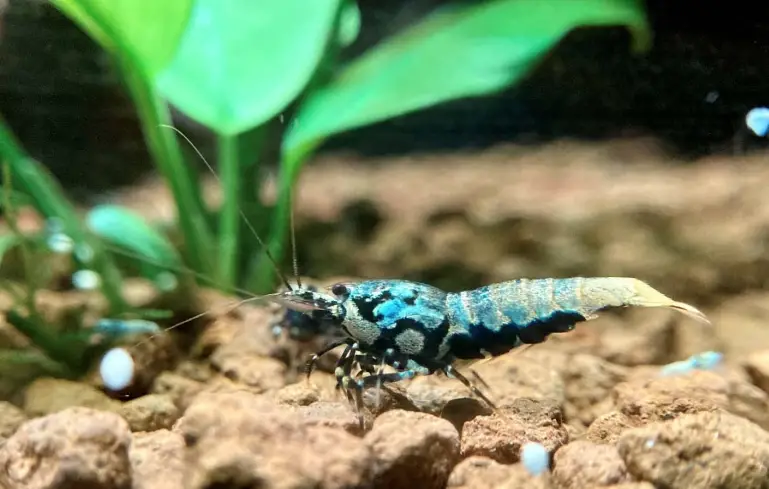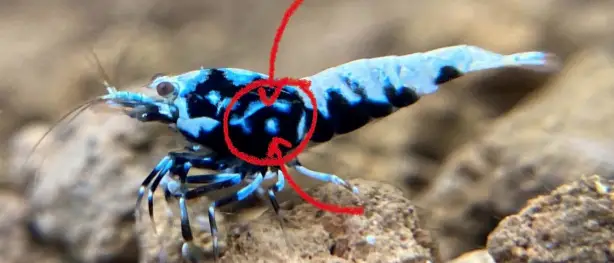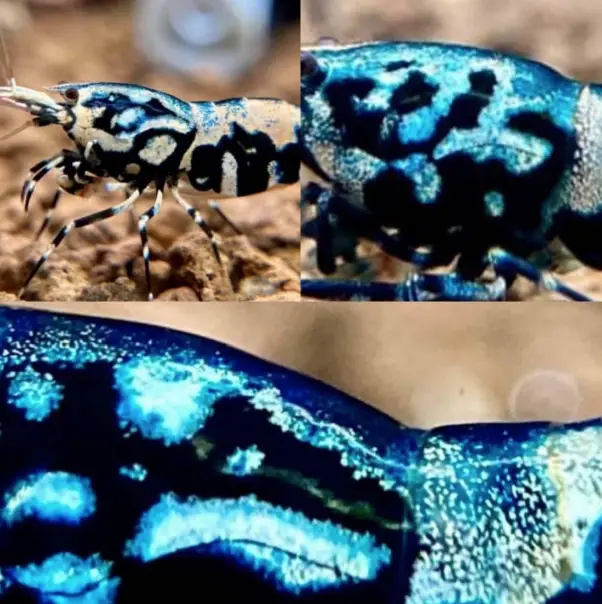Original Post By Kerric Peyton, December 2021 You can find him on Facebook here.
Boa for sale! Look at my BOA! But is it REALLY, though? Who says? Why do they think that? Spoiler alert,
it depends on who you ask. Warning, I love this subject and will drone on forever about it. A qualifier, I have established a small colony of caridina that produces and contains a few of what I consider to be boa shrimp.
I have cobbled this colony together, among several other colonies that I enjoy, by buying and selectively breeding galaxy pintos with large head spots and thick fishbone or cape-like patterns that were said to have “boa genetics”.
Some would call these “boa culls.” I have never sold a shrimp that I’d consider to be a boa and don’t expect to unless I get very lucky one day and can produce them more consistently or in greater numbers.I don’t anticipate that happening but you never know!
My goal, honestly is to take beautiful macro pictures of my shrimp that I can share for others to enjoy and see. I use a clip-on macro lens on my iPhone and don’t really aspire to go any further than that. It satisfies my goal!
I have bred many shrimp that were born and died in my tanks and the only evidence that they ever existed is a picture I took of them. My hobby is actually taking pictures of my shrimp and sharing them, which requires me to breed them.
and the only evidence that they ever existed is a picture I took of them. My hobby is actually taking pictures of my shrimp and sharing them, which requires me to breed them.
Getting into some of my thoughts and opinions. What is this elusive and coveted boa shrimp? Why does
it seem to be the most controversial designation in the hobby? They’re beautiful, rare and expensive
when you can find one to buy.
What makes a boa a boa? Why can’t you just go online to the major sellers of shrimp and buy 10+1 boa starter packs? Why can’t one ask “what is an average price for a boa”? Why do we have to usually send a PM to get details? Why are most boa sold WYSIWYG? Why aren’t boa prevalent on the common auction sites? Is a galaxy pinto with a cape pattern and large head spots a boa?
Is a galaxy fishbone patterned shrimp with large head spots a boa? Is a boa just basically a metallic galaxy
fishbone? Does a boa have to be metallic? Are there actually grades of boa? Says who? Why do they
say or think that? So many questions.
I think, right now, outside of a small group of expert breeders (not me) and qualified judges (certainly not
me), what makes a boa is in the eye of the beholder, often times the potential buyer. I would offer that
anyone who is asking has doubts (including myself) but when they see one they know.
It’s that kind of thing. Several experts, they need no introduction, have produced videos on boas and even boa grading and they are useful. These videos are actually the only resource material that I could find on this subject.
So, a better question than “what makes a boa a boa” right now might be “what makes a boa a boa to me”
and when I say “me” I don’t mean me. I mean the person breeding for them, a potential buyer, or “you”
or “the interested individual”.
I think that a potential boa buyer or someone seeking to have boa’s is a good judge of this because they know what they are looking for. When they see it they know it, especially if they are a serious buyer who has done their research. Just like the experts I referenced earlier, a true boa shrimp usually needs no introduction.
Most of us know one when we see one and if you are new to the hobby, when you see a “real” boa you will usually be in awe of how beautiful and unique it is and ask “what is that?!?”. So, they have a look that is special, different and unique among caridina variants.
I would even go as far as to say it’s an unmistakable look. Describing it is another matter.

What makes me qualified to offer an opinion on this? Nothing. I’m doing it as someone who is personally
interested in the subject who has done as much research as I’m willing to do and who aspires to have and
breed shrimp that I consider to be boas so that I can photograph them and share the photos.
I am breeding for the traits that, based on the limited resources available to me and my own opinion, constitute a boa shrimp. So, to address that. What makes a boa a boa TO ME is the question I’ll attempt to answer! A few things.
For my colony, a boa shrimp must be a caridina pinto with a certain pattern AND color characteristics.
Remember, I said for MY colony and in my opinion.
First, a boa in my colony should have a specific pattern. For pattern, it should have large and expanding
head spots, a thick fishbone pattern that runs together or a cape like pattern on the back that blends or
flows into the head spot pattern.
The most important part of a boa pattern to earn that designation in
my colony is the pattern on the shrimp’s head.

Galaxy pintos with capes on their tail areas are easy to find and get. So what separates a galaxy pinto
pattern with a cape on its back from a boa pattern? Simply put, the head pattern.
That is easy for me to see and recognize in my colony but harder for me to describe. Spots, how much area they cover, how they cover that area, how they flow, their shape and how they change as the shrimp grows.

For my colony I’ve noticed that a good indicator I can observe early on, as to weather a shrimp will develop from galaxy to boa is that some of mine that do turn into boas have a distinctive spot combination on their head when they are young, and you can see the remnants of it in the adults most of the time.
It resembles a half circle or a “rocker” with a dot below it. My guess is that this is a characteristic of whatever line of boas mine descended from. I don’t know but many of my young that developed into boa started with this pattern characteristic.

I certainly did not invent my boa shrimp. I selected for them from an already established boa gene in
galaxy pintos that I acquired. If a juvenile shrimp in my colony has nice big head spots, a thick fishbone or
cape backline and this distinctive rocker and dot on the head / cheek, I am excited that it might mature
into a boa.
Second, color. In my colony, to earn the title of boa the shrimp should have color beyond its base color.
We can break this down into two broad color categories, black and red pintos. To me a black pinto boa
should have colors that intrude into the normal black and white areas.
These colors grow on top of the base colors and start at and expand from the border between black (or red) and white. Black pintos that I would consider for the coveted boa designation in my colony should have blues, silvers, golds or other color variations present on and ideally growing out across them.
Beyond that a metallic tint to these colors helps convince me that a shrimp has the colors that might make it a boa in my colony.

I have no red boas, but I know one, in my opinion, when I see one. They should have colors that depart
from their base color as well that are usually gold, orange or pink hues and can also show a metallic sheen, making it a more convincing boa…to me.
None of my shrimp are considered to be a boa by me when they are young because ALL of my boas started out as galaxy pintos much like their siblings. Some have hints that they will mature into boas (e.g. larger head spots, blue colors at an early age or the distinctive rocker and spot below it on the cheek) but not all.
They usually only meet my requirements when they reach maturity as the spot pattern has grown in
and their colors, beyond base colors have started to develop and spread. As I said, and will say again
because it’s so cool, boas in my colony start as galaxies but unlike their galaxy siblings their spots grow
and change much more both in shape, coverage, sheen and color as they mature. Truly fascinating and
exciting to watch!

So, in my colony, a boa is a pinto that would otherwise be considered a galaxy pinto if it didn’t GROW
INTO the color AND pattern characteristics mentioned above. So, that is, in my unqualified opinion, based
on my colony and goals, what I consider a boa shrimp to be.
Some additional thoughts and notes:
Many galaxy pintos in my colony will have the additional colors described above, including metallic but
won’t have the boa pattern. Some shrimp will have a boa type pattern but will lack the color varieties
that I feel make them a boa to me.
Neither of these do I consider a boa in my colony however I might keep them around, if males, until they mature further and if they are females, to breed back to males that I consider boa or that have a boa pattern that I feel will be complimented by the females.
As I said above, most of us know a boa when we see one. So what do shrimp with capes and galaxy spots look like thataren’t boa? I would offer the ones below from my colonies.

Top left: mature female galaxy fishbone I used in my boa project for a while.
Top right: mature berried galaxy fishbone female which came from boa showing blue coloration.
Middle left: juvenile caped galaxy fishbone from boa parents that never developed into a boa.
Middle right: caped red galaxy pinto, the only red shrimp my boa colony has ever produced.
Bottom left: juvenile caped galaxy pinto from boa parents.
Bottom right: beautiful galaxy pinto female that I used in my boa project for a while
showing all characteristics of boa color but not pattern, specifically on her head.
One characteristic I have noted in my boa shrimp is that as previously mentioned their pattern and color
changes dramatically as they age. In some cases, they are most attractive to me at a mid‐stage in this
evolution when they have larger spaces between their head spots.
But all of my boas change pattern and color as they age much more dramatically than my galaxy shrimp do. This process goes on for the shrimp’s entire life. Below are a couple of boa examples I’ve documented since they were young.

Three pictures of the same shrimp above. First at 3 months, second at six months and third at one year.
This was an exceptionally high potential shrimp from the very start, and she shows the changes in color
and pattern indicative of a boa in my colony (as well as the rocker/dot pattern mentioned above).

Another boa that I found interesting from the very beginning. Four pictures of the same shrimp taken at
different times in her development. She was different than her siblings as she had a messy head
pattern. I suspected she would change dramatically as she grew so I documented it. Her pattern isn’t
ideal, but she will pass her boa genetics on to her offspring and is one of my favorite shrimp
It has been very hard for me to develop a true boa male in my colony. Many have the requisite pattern I
look for but few show colors that depart from their base colors and I have not been able to produce a boa male that shows significant amounts of metallic,
My best boa males so far have light blue hues where black meets white. The males that I breed to my boa females usually don’t have the degree of richness of color beyond their base colors that the females do.

Two of my better boa males
A good way to decide if the shrimp you have is a boa or not is to ask those you respect who have and
breed and show their boa’s. If one is not willing to put the question out there, it is probably a pretty
good sign that they themselves are not all that convinced either. And, getting back to an earlier
statement I made, opinion of course, is that most experienced hobbyists know it when they see it. So, in
conclusion, what do we really KNOW about what makes a boa a boa!?! SAYS WHO?!?
I welcome and look forward to any and all comments on this.
Special thanks:
To master boa breeder, Kelvin Wong, for reviewing this information before I put it out there.
His insight and confirmation of some of what I’ve observed gave me great confidence.
To Alan Huang, my best shrimp amigo who has been an advisor and encourager from the
beginning of my shrimp obsession.
To Warwick Cottee, for being the person I go to with tough shrimp questions like what in the
world is happening in my tank or what is the genetic makeup of this or that caridina variant.
